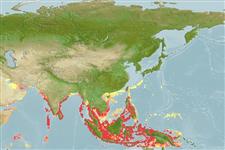Actinopterygii (ray-finned fishes) >
Clupeiformes (Herrings) >
Clupeidae (Herrings, shads, sardines, menhadens) > Dorosomatinae
Etymology: Sardinella: Latin and Greek, sarda = sardine; name related to the island of Sardinia; diminutive (Ref. 45335).
Environment / Climate / Range
Ecology
Marine; brackish; pelagic-neritic; depth range 0 - 50 m (Ref. 188). Tropical, preferred 28°C (Ref. 107945); 30°N - 11°S, 47°E - 153°E (Ref. 188)
Indo-West Pacific: from Kuwait to southern India and Bay of Bengal to the Philippines, also eastern tip of Papua New Guinea. Often confused with Sardinella gibbosa in Indian waters.
Length at first maturity / Size / Weight / Age
Maturity: Lm 13.3, range 11 - ? cm
Max length : 13.0 cm SL male/unsexed; (Ref. 188); common length : 11.0 cm SL male/unsexed; (Ref. 188)
Dorsal
spines
(total): 0;
Dorsal
soft rays
(total): 13-21;
Anal
spines: 0;
Anal
soft rays: 12 - 23. Body somewhat compressed but variable; total number of scutes 29 to 33. Vertical striae on scales not meeting at center, hind part of scales with a few perforations and (in Indian Ocean specimens) somewhat produced posteriorly. A dark spot at dorsal fin origin.
Forms schools in coastal waters. Misidentifications (especially with S. gibbosa in Indian waters and S. albella in the western Indian Ocean) make published biological data potentially unreliable. Marketed fresh, dried-salted, boiled or made into fish balls.
Whitehead, P.J.P., 1985. FAO Species Catalogue. Vol. 7. Clupeoid fishes of the world (suborder Clupeioidei). An annotated and illustrated catalogue of the herrings, sardines, pilchards, sprats, shads, anchovies and wolf-herrings. FAO Fish. Synop. 125(7/1):1-303. Rome: FAO. (Ref. 188)
IUCN Red List Status (Ref. 115185)
CITES (Ref. 94142)
Not Evaluated
Threat to humans
Harmless
Human uses
Fisheries: commercial
Tools
Special reports
Download XML
Internet sources
Estimates of some properties based on models
Phylogenetic diversity index (Ref.
82805): PD
50 = 0.5000 [Uniqueness, from 0.5 = low to 2.0 = high].
Bayesian length-weight: a=0.00813 (0.00524 - 0.01260), b=2.97 (2.84 - 3.10), in cm Total Length, based on LWR estimates for this species & Genus-body shape (Ref.
93245).
Trophic Level (Ref.
69278): 2.7 ±0.30 se; Based on food items.
Resilience (Ref.
69278): High, minimum population doubling time less than 15 months (K=0.7-1.6; tmax=3).
Vulnerability (Ref.
59153): Low vulnerability (10 of 100) .
